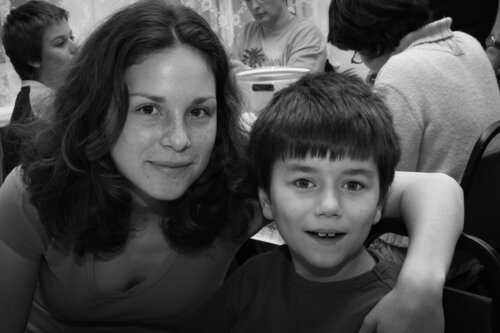Mentoring
How do we perceive volunteer mentoring?
Similar to volunteering, mentoring has many different definitions and interpretations. In NAD, we most often use the following formulation:
"Mentoring is a professional relationship between two individuals, where the mentor shares their experiences and knowledge with the mentee. The mentor thus acts as a guide in a particular area or topic and helps the mentee find the right direction or solution. We consider volunteer mentoring to be one of the forms of social inclusion for clients."
The basic principles of volunteer mentoring that we recognize are:
- A unique relationship between the mentor/volunteer and the mentee
- Longevity
- Regularity
- Reciprocity (mutual relationship)
- Fun
- The volunteer helps the mentee’s development
- The safety and well-being of the mentee – the mentee comes first
- Reliability and responsibility of the volunteer – predictable presence and long-term relationship
- Professionalism of the volunteer – openness, authenticity, boundaries of the relationship
- Respectful approach of the volunteer towards the mentee, their background, and life situation
Mentoring Programs
Among the volunteer mentoring programs implemented by our member organizations are, for example, Five P, KOMPAS, KAMPa 15+, tutoring for children from socially excluded backgrounds, Second Hands, mentoring with patients from psychiatric hospitals in home care, mentoring with foreigners, and others.
Five P
The history of the Five P program and why it has a “special place” in the association
The Five P program was the first professionally managed volunteer program in the Czech Republic. The Five P program is based on the American Big Brothers Big Sisters program, which has been operating worldwide since 1904, and is founded on the mentoring relationship between a child and a volunteer. The mission, rules, and principles of the Five P program are derived from Big Brothers Big Sisters. The program was first implemented in the Czech Republic in 1996 by the HESTIA organization in Prague, and based on the experience of PhDr. Olga Sozanská from her internship in the USA, the first brief methodologies for the program were created. Due to the need for professionalism in the management of this program after its expansion to other cities, the Five P Association was founded in 2001 in the Czech Republic. In 2015, in connection with new legislation and the gradual development of other mentoring programs, it was transformed into the Association of Volunteer Mentoring Programs, z.s. In 2018, the association also gathered other volunteer organizations and was therefore renamed to the National Association of Volunteering, z.s. This association supports and provides methodological guidance to all Five P centers in the Czech Republic.
These are the reasons why the Five P program has its “special place” within the association, and we will continue to focus on its support, development, and promotion.
Big Brothers Big Sisters (BBBS) – The roots of the Five P program
Big Brothers Big Sisters (BBBS) is the world’s largest mentoring program. It helps children around the world reach their potential through a professionally managed one-on-one friendship with measurable outcomes. Having a mentor is a victory in a child’s potentially vulnerable life – someone outside the family who offers exclusive friendship to the child. The mentor and child share many different activities together, but the fundamental purpose is simply being together. The friendship supports the child’s decision-making, creativity, and perseverance. It motivates the child to have faith in a better future and to believe that their dreams can come true. The BBBS program began in 1904 in the USA, and throughout the 20th century, the development of this unique support for children focused only on English-speaking countries. In the early 1990s, the BBBS program began expanding worldwide, primarily due to the internet and websites. A second influence was pioneering research evaluating the program’s impacts, conducted in the USA. According to McGill (2001), no other program serving young people had such extensive control and such a positive impact. The first country in Central and Eastern Europe where the program was introduced was Lithuania, followed by the Czech Republic.
What is the Five P program about?
It is a social preventive program for children, based on volunteer lay assistance. The five Ps in the name stand for Přátelství, Prevenci, Pomoc, Péči a Podporu (Friendship, Prevention, Help, Care, and Support). These are the principles the Five P program strives to fulfill. The form of assistance is offering a friendly relationship between an adult volunteer and a child. The pair meets once a week for 2-3 hours in their free time, for at least one year. This creates a long-term friendly relationship, which is a huge benefit for both children and volunteers in terms of personal development and interpersonal relationships. The program should not replace parental care, it is not child-sitting, nor should it become just tutoring. The goal is the friendship between the child and the volunteer, and everything that comes with it. The program should continuously include joint recreational activities for both children and volunteers, and may even include a summer camp. The Five P program adheres to human rights and basic personal freedoms, maintaining the dignity of children and their families, and takes place in their natural social environment. The implementation of the Five P program is overseen by a coordinator.
Who is the program intended for?
Children aged 5 to 17 years (individual centers may have slightly different age limits) who could benefit in any way from an additional relationship with an adult. The child’s parent(s)/guardian(s) must consent to the child’s inclusion in the program.
In the Five P program, we most commonly encounter the following types of children:
- Children from socially disadvantaged families or low-stimulus environments,
- Children from problematic family environments,
- Children in foster care,
- Newly arrived children, children from different sociocultural backgrounds,
- Children with behavioral problems, hyperactivity, attention disorders, etc.,
- Children who have been victims of bullying,
- Children with disabilities or children from families where there is a serious disability,
- Anxious children, children who engage in self-harming or other risky behaviors,
- Lonely children who are unable or unwilling to make friends.
Children are recommended for the program primarily by various professionals, such as psychologists, psychiatrists, social workers, curators, educational counselors, teachers, child protection officers, and others. The program coordinator can also be contacted directly by legal guardians or caregivers.
Who is a volunteer in the Five P program?
Volunteers are individuals who want to help others. They are carefully selected and professionally trained for the program. One of the requirements is being over 18 years old. Volunteers must undergo an introductory training, including psychodiagnostics, and during their meetings with their younger friend, they attend regular supervision sessions with the coordinator and supervisor. Volunteers are constantly in contact with professionals who run the program and help them address any issues that arise.
The Five P program is also beneficial for volunteers. Choosing to dedicate part of their free time to a child demonstrates their sense of social responsibility. Participation in the program offers volunteers the opportunity to relive their own childhood, take a break from daily worries, and allows for personal development, gaining new experiences, knowledge, and skills. They also gain a sense of being needed, meaningfulness, and, last but not least, practice a basic civic virtue—helping others. Volunteers most often cite the sense of meaningful work, the opportunity to expand and deepen their qualifications, appropriate use of free time, and strengthening of self-confidence as the main benefits. Motivations for volunteers also include their relationship with children, the willingness to help them, the desire to learn more about themselves, the feeling of usefulness, the experience of fun, the opportunity to return to childhood, or preparing for parenthood or a career.
Who is responsible for the Five P program, including the children and volunteers?
The coordinator is a key figure in every volunteer program. They recruit volunteers, prepare volunteer training, collaborate with the parents of children enrolled in the program, supervise the child-volunteer pairs, and more. The Five P program is implemented at the so-called Five P centers, which are usually non-profit organizations that have signed a Cooperation Agreement for the Five P program with the NAD.
It is precisely the coordinators and centers within the National Association of Volunteering, z.s. that we offer support to.




